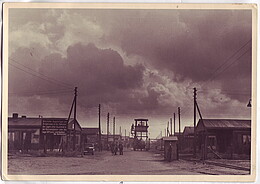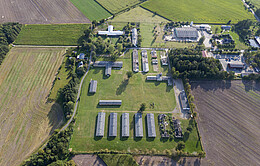Sandbostel
In 1939, a large POW camp (Stalag X B Sandbostel) was established in Sandbostel near Bremervörde. This camp was a transit station for hundreds of thousands of prisoners from many different nations. In April 1945, the SS housed prisoners from the Neuengamme concentration camp in a separate part of this POW camp. Around 9,500 men, many of them from the satellite camps in Bremen, Wilhelmshaven and the Emsland region, spent the last weeks of their imprisonment in Sandbostel. There were insufficient provisions, and a typhus epidemic broke out as well, so many prisoners died in Sandbostel.
During an air-raid alarm on the night of 19 April 1945, several hundred prisoners stormed a kitchen hut to find food. During the same night, the SS left the camp and headed in the direction of Flensburg with several hundred prisoners who were still “able to march”.
Until the British army arrived on 29 April, the remaining concentration camp prisoners were largely left to their own devices and were given emergency rations by the POWs in the neighbouring camp.
Over 3,000 concentration camp prisoners died in Sandbostel between 12 and 29 April 1945 and in the following weeks as a result of their imprisonment.
Period
12 - 29 April 1945
Number of Prisoners
9500 Male Prisoners
Kind of Work
-
Labor on Behalf of
-
Location
Directions
Cemetery: Bevener Straße, 27446 Sandbostel, Germany
Site of former camp: Immenhain industrial estate, Greftstraße, 27446 Sandbostel, Germany
Directions by public transportation: The Sandbostel documentation centre in Bremervörde is around 1 kilometre from the Bremervörde railway station (Hamburg–Bremerhaven line).
Memorial
Tens of thousands of POWs and 2,700 victims of the Neuengamme concentration camp are buried in the Sandbostel war cemetery. The gravesite of the concentration camp prisoners is located at the front of the cemetery on the right, and there is also a memorial plaque dedicated to the victims of the Neuengamme concentration camp.
The POW camp was used as an internment camp by the British from June 1945 to early 1948. From 1952 to 1960 it served as a transit camp for young men who had fled from the GDR. Since 1974, most of the grounds of the former camp have been occupied by the Immenhain industrial estate. The numerous architectural remains from the camp – consisting of around 30 huts and other buildings – were placed under a preservation order in 1992 but continued to fall into decay. The part of the camp in which the concentration camp prisoners were provisionally housed had already been turned back into farmland by 1945.
The “Dokumentations- und Gedenkstätte Sandbostel e. V.” organisation was founded in 1992 with the aim of researching the history of the camp and establishing a memorial at the site of the former camp in Sandbostel. Because this has not yet been possible, the organisation opened a provisional documentation centre on 28 January 1998 about ten kilometres away in Bremervörde with a permanent exhibition on the POW camp and the “reception camp” for concentration camp prisoners. The organisation also offers tours of the grounds of the former camp and the camp cemetery.
After years of opposition from the community of Sandbostel and local businesses, a compromise was finally negotiated via the state government in the summer of 2004: A documentation centre worthy of the location is to be established at the back of the site of the former camp. It will be funded by a foundation established in December 2004 made up of representatives of the community of Sandbostel, the district of Rotenburg, the federal state of Lower Saxony, the “Dokumentations- und Gedenkstätte Sandbostel” association and other organisations.
Opening hours:
Mon.-Fri. 9:00 AM–4:00 PM and by appointment.
Contact
Stiftung Lager Sandbostel/ Gedenkstätte Lager Sandbostel
Greftstr. 3
27446 Sandbostel
Germany
Tel.: +49 (0) 4764 – 2 25 48 10
Fax: +49 (0) 4764 – 2 25 48 19
Email: info@stiftung-lager-sandbostel.de
Homepage: https://www.stiftung-lager-sandbostel.de/


